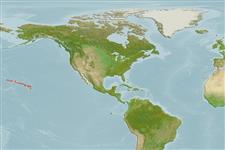>
Dactylopteriformes (Flying gurnards) >
Pegasidae (Seamoths)
Etymology: Eurypegasus: Greek, eurys = long + Greek, Pegasus, pege = springs of Ocean near which Medusa was said to have been killed; the winged horse, sprung from the blood of Medusa (Ref. 45335); papilio: From the Latin word 'pipilio' meaning butterfly..
More on author: Gilbert.
Environment: milieu / climate zone / depth range / distribution range
Ecologia
marinhas demersal; intervalo de profundidade 80 - 291 m, usually 80 - 115 m (Ref. 58302). Tropical; 28°N - 20°N
Eastern Central Pacific: known only from the Hawaiian Islands.
Tamanho / Peso / Idade
Maturity: Lm ? range ? - ? cm
Max length : 7.6 cm SL macho/indeterminado; (Ref. 583)
Espinhos dorsais (total): 0; Raios dorsais (total): 5; Espinhos anais 0; Raios anais : 5; Vértebras: 19. Body color olivaceous to yellow olive dorsally and laterally; whitish ventrally; 3 indistinct, double bands of light red on carapace and tail. Species with 3 pairs of dorsolateral body plates; 4 pairs of ventrolateral body plates; a pair of deep pits on dorsal surface of head; 8 (rarely 9) mobile tail rings; concave suborbital shelf, eyes visible in ventral view. Dorsal and ventral ridges of rostrum almost equally expanded with laterally directed denticles. Medial spine on dorsal surface of last tail ring posteriorly directed.
Inhabits moderately deep water (Ref. 1418). Benthic (Ref. 58302). Larvae and juveniles are often collected in neuston and plankton nets, and midwater trawls (Ref. 1418).
Ciclo de vida ou comportamento de acasalamento
Maturidade | Reprodução | Desova | Ovos | Fecundidade | Larvas
Palsson, W.A. and T.W. Pietsch, 1989. Revision of the Acanthopterygian fish Family Pegasidae (Order Gasterosteiformes). Indo-Pac. Fish. (18):38 p. (Ref. 1418)
Status na Lista Vermelha da UICN (Ref. 130435)
Ameaça para os humanos
Harmless
Uso pelos humanos
Mais informação
ReferênciasAquaculturaPerfil para aquaculturaEstirpesGenéticaElectrophoresesHereditariedadeDoençasProcessamentoNutrientsConversão de massa
ColaboradoresFotosStamps, Coins Misc.SonsCiguateraVelocidadeTipo de nataçãoÁrea branquialOtólitosCérebrosVisão
Ferramentas
Relatórios especiais
Baixar XML
Fontes da internet
Estimates based on models
Preferred temperature (Ref.
123201): 4.8 - 13.7, mean 6.4 °C (based on 6 cells).
Índice de diversidade filogenética (Ref.
82804): PD
50 = 0.7656 [Uniqueness, from 0.5 = low to 2.0 = high].
Bayesian length-weight: a=0.01000 (0.00244 - 0.04107), b=3.04 (2.81 - 3.27), in cm total length, based on all LWR estimates for this body shape (Ref.
93245).
Nível Trófico (Ref.
69278): 3.2 ±0.4 se; based on size and trophs of closest relatives
Fishing Vulnerability (Ref.
59153): Low vulnerability (10 of 100).
